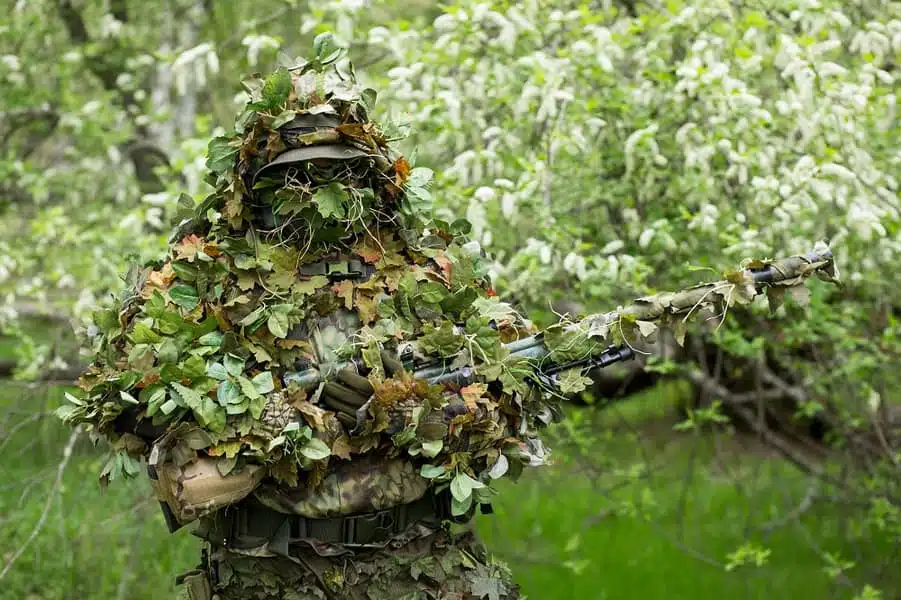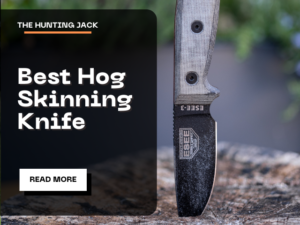Ghillie suits have been around for quite a long time and the art of staying hidden has been improving a lot in the last few decades. Knowing how to make a ghillie suit that will keep you concealed both on the airsoft field and on the hunting grounds is relatively easy. While 2-dimensional (2D) suits do an okay job at blending you in with your surroundings, 3-dimensional (3D) suits are the ones that really hide your silhouette, which is the number one fear factor for most of the game you will be going after.
In this article, we will be going through the process of making exactly those 3D suits that work excellently in all types of conditions.
To make things fit perfectly for your needs, all you have to do is follow the instructions and steps across the whole process that I’ve laid out for you. These steps include:
- Inspect your surroundings
- Gather supplies
- Choose a foundation for your suit
- Fishing nets and burlap preparations
- Hoodie and gear wraps
- Add the finishing touches
If you want to skip all that and get yourself a great model, head over to my guide on some of the best ghillie suits for 2023 and see some of my top recommendations!
Inspecting Your Surroundings
The very first thing you have to do before you start gathering supplies and choosing different clothes and materials for your ghillie suit is to take a good look at the terrain you will be hunting in. If you are making the ghillie suit for an airsoft field, you can safely bet on a mix of green colors which will cover most types of airsoft fields and forests. However, if it is a dry grass field with constructions on it, then go with yellow/sand beige colors.
If you’re now getting into hog hunting and want to make a suitable ghillie, choose one that has a mix of leaves and grass elements, as you will move a lot from forests to open fields and back to forests when you’re tracking.
As a whole, the top layer of most home-made ghillie suits can be changed and stripped relatively easy and I will show you how further down. The point is that you can adjust your suit according to your surroundings on the go.
Gathering Supplies
This is the most important part of the whole process and requires the most amount of work. Here is the list of all the items that we will be using:
- Your base layer clothes (suit)
- Netting
- Jute/Burlap
- Tape
- Shoe glue
- Dyes and coloring (optional)
- Organic material (on-site)
The process of finding parts for your ghillie suit will be dynamic and your preferences will change a few times until you get exactly what you imagined. Either way, start from the bottom layer and keep adding on top…
Choosing Your Suit Foundation
The foundation for the ghillie suit can be a few things. Most people go with regular camouflaged clothes or solid-color suits (dark green, yellowish, etc). Clothes that are already camouflaged like military suits are the best option but can be a bit expensive. Military flight suits and battle dress uniforms (BDU) work excellently as they are designed for heavy-duty use and will act as a solid foundation for the sewing and adding of elements.
What is important to remember here is to always choose base colors that will match the terrain you’re trying to blend in with. Furthermore, look for clothes that will have good thermal properties. Thicker suits are mandatory for colder climates. For warmer climates, you can even get a net poncho or the top part of a ready-made ghillie suit which consists of a poncho and flaps. If you hunt primarily during the winter and want to have extra insulation below your ghillie, head over to my guide on some of the best base layers for cold-weather hunting.
Using nets and burlap

If you’ve gone with the military type suits (BDUs) for your base layer, then you’ve chosen the best type of foundation thanks to how easy it is to sew more materials on top of it. The thing that will hold the rest of your ghillie suit on top of the foundation layer is going to be the netting. Normal mesh netting or fishing net is something that works perfectly. A fishing net is slightly better since its much sturdier. Some fishing stores sell replacement fishing net pieces which are absolutely perfect for our goal! There are even knotted ghillie nettings that are sold on amazon.
Sew those strips of the net to your suit spaced by empty strips of around 5-6 inches. Dental floss or fish line work best for durable long-lasting seams. Once you cover your whole suit with these net strips, it is time to get to the hardest part of the whole suit – the adding of burlap or jute threads.
Typically, ghillie suits are covered in large strands of braided jute or burlap thread. You can get these from all sorts of places even items like coffee bags or bulk rolls of netting. For every suit you want to make, you will need around 6-10 pounds of burlap. In my opinion, the easiest way to bypass separating the jute into single fibers is to buy a ready roll of ghillie suit thread. In most cases, these are pre-cut into spammer pieces of around 20 inches and come at packs of 1-10 pounds. What’s even better is that there are a ton of colors available such as Mossy, Dry Grass Mix, Forest, Olive, Jade, and others.
Finishing up
Once you’ve unraveled the jute or burlap materials (or have bought ready suit threads), it is time to tie them into the net strips you’ve sewn earlier into the suit. There are different ways to do that but the easiest and fastest method is by folding and tying the strands with themselves.
That method requires no extra materials and is good to know it for those times you need to do a quick field adjustment to the suit. Basically, grab a bundle of threads and fold them. Push the loop you just made through a single square of your net strip. Take the hanging end of that bundle and draw it through the loop. Pull tightly and you have your first braid of ghillie thread on your suit! Work your way up the suit using differently colored threads (if needed) and different pattern combinations.
Hoodie and gear wraps
If the suit you initially bought for the foundation has a hoodie, this step will practically be a continuation of the last one. If you didn’t get a hoodie, then you will have to make one. You can salvage a torn hoodie for its hood or just use a patch of material to make one. Sew a patch of fishing net on top of it and wrap it in burlap thread just like we did earlier with the suit.
For your weapon, backpacks, and other types of gear, there are a few different approaches but they all fall down on the base knowledge we just covered in the previous steps. For a longer rifle, you can use wrapping tape. That will be the easiest, hassle-free, and noise-free way to conceal your weapon. Backpacks can also be transformed to blend with your ghillie suit but it will be a bit trickier if you want to keep the day pack untouched from stitching.
Finishing Touches
Some of the things that you can add to the process in order to make the suit as perfect as possible are:
- Covering all the seams and stitches with shoe glue
- Making sure that all the netting is held firmly
- Testing waterproofing if there is any
- Adding the organic layer of your ghillie suit
The steps with the shoe glue might seem redundant but it really increases the longevity of your suit and will even keep it better insulated against water dripping inside (if you’ve gone through waterproofing it). Next, check if all the net and burlap you’ve wrapped around is secured tightly and doesn’t move too much. Nothing is worse than catching a branch with your newly made ghillie suit and destroying it all as soon as you pull a bit harder.
Adding the organic layer is the true final step to any good ghillie suit. This will consist of branches, leaves, grass, and even mud from the area in which you’re hunting or playing airsoft or paintball. Make sure you use your attachment points and netting appropriately to lodge branches and leaves in there. Remember to keep noise in mind – a suit with too many elements and organic material can be extremely noisy even from the slightest movements you make, rendering your concealment useless.
After all that is done, it is time to take your suit out and test how effective it really is! If you want to learn more about hunting with a ghillie suit, click here…
Conclusion
When you’re faced with various terrains for your airsoft team challenges or hunting trips, your concealment will often struggle to keep up with the changing conditions. Learning how to make a ghillie suit and sleeves for your weapons, however, will give you the ability and flexibility to adjust your gear according to the constantly changing surroundings. Once you master the whole process, making a proper suit for all types of forests and grass fields will turn into a fun project!



